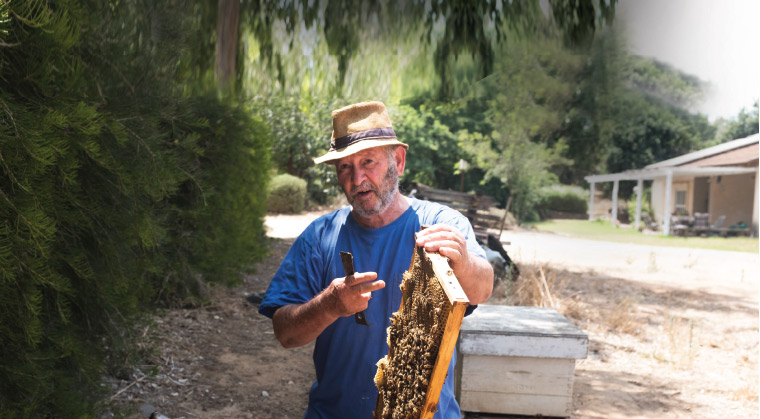Busy as the Bees
| September 5, 2018
Yehuda picks up a metal smoker filled with dry twigs and lights it. Then he gently opens the hive and uses the smoke to disperse the bees (Photos: Lior Mizrachi)
R
osh Hashanah may still be several weeks away, but at Kfar Pines, a religious agricultural settlement near Hadera, in northern Eretz Yisrael, at least one person is already working to ensure Am Yisrael will have a sweet new year: frum beekeeper Yehuda Kendal.
Greeting us with offers of cold water, Yehuda looks like the typical born-and-bred Israeli moshavnik, with his hat, T-shirt, and weather-beaten skin. Actually, he was born and raised in the coastal city of Netanya. Despite the urban upbringing, he was drawn to working the Land of Israel. Therefore, after his army service — he fought on Jerusalem’s Ammunition Hill in the Six Day War — he tried Kibbutz Be’erot Yitzchak, a religious kibbutz in central Israel. In 1969, the Kendals moved to Kfar Pines, where they raised five children.
Kfar Pines was founded in 1933 by new immigrants from Eastern Europe. Today, it’s home to more than 1,000 people — and several thousand bees, thanks to Yehuda’s apiary. There he produces several types of honey and other honey-related items geared toward the connoisseur in search of top-quality products, with a hechsher to match.
ABC's of Bees
Introductions over, Yehuda picks up a metal smoker filled with dry twigs and lights it. We head toward a hive, a low white box on the ground, and he tells us where to stand in the shade to avoid stings. Then he gently opens the hive and uses the smoke to disperse the bees.
“Bees are essentially forest animals,” he explains. “The forest has the blossoms and flowers they need, and it has hollow tree trunks or rocks that they can adopt as living quarters. Fire in a forest means that all the vegetation has become dry and burnt. If bees smell fire, they stop all activity, and fill their stomachs with honey to last a few days, until they’ve found a new habitat.”
He pulls out one honeycomb, a square wooden frame swarming with black-and-yellow furry insects. A waxy spread of honeycomb reveals liquid gold in a few open cells. Yehuda is almost paternal as he points out the smaller insects, the male babies, crowded into the center of the comb.
The beehive resembles a house with multiple stories. The door is at the bottom, where the queen bee lives, in her own chamber. The worker bees buzz in and out, bringing plant nectar that they ingest and regurgitate until it is stored as honey in the cells of the honeycomb. Then, they flutter their wings to circulate air and evaporate water from the honey, and seal the cells with wax.
Building and maintaining the hive is also part of a bee’s workload. Yehuda shows us the bee’s natural sealant: black propolis, a resinous mixture that feels somewhat like putty. The bees produce it by mixing saliva and beeswax with the exudate gathered from buds and nectar.
When the honey is harvested, the top layers of the hive are removed but the bottom stays put, so that the colony survives and the bees have enough food left to survive the winter. In good seasons, when plenty of rain has fallen and the flowers are in full bloom, Yehuda adds additional levels to his hives for the increasing population.
It’s fascinating to realize that just like almost everything else in Creation, bees depend on rain for their prosperity. Yehuda points upward. “It’s all from Shamayim. If the rains come, the trees blossom and the orchards are heavy with fruit — and then the bees have food and the hives get bigger and busier.”
In the winter, the hive is home to around 5,000 bees. That number expands to between 30,000 and 40,000 insects, mainly worker bees, in the summer.
(Excerpted from Mishpacha, Issue 726)
Oops! We could not locate your form.







